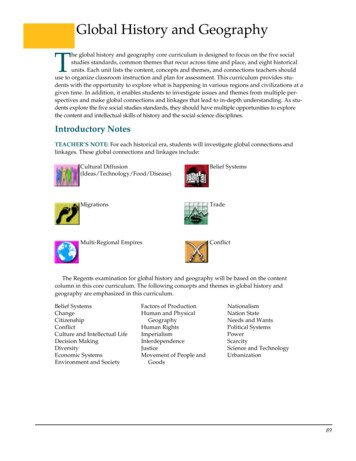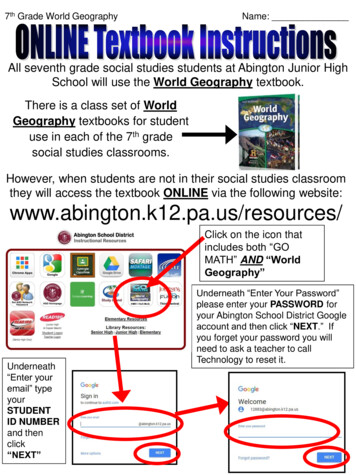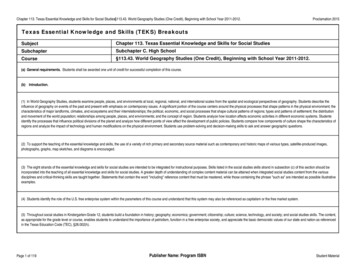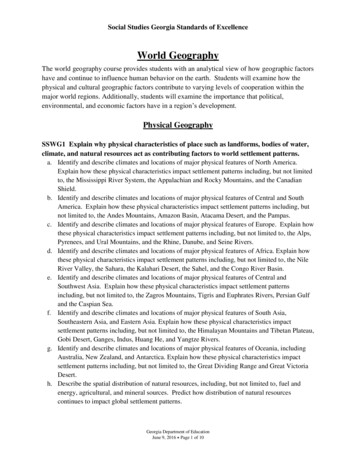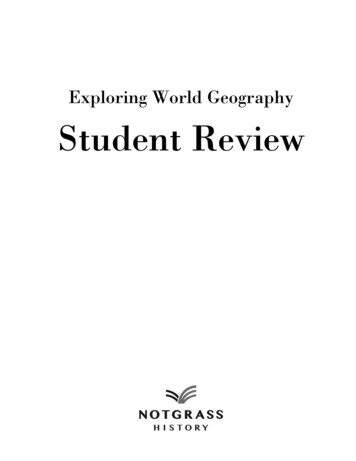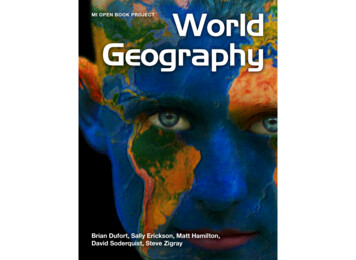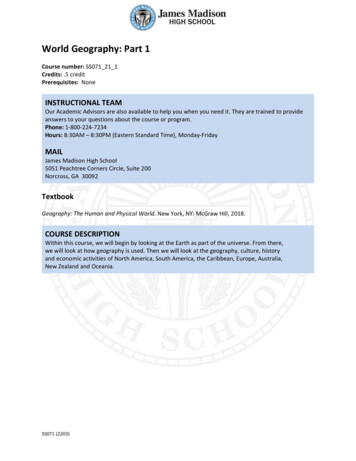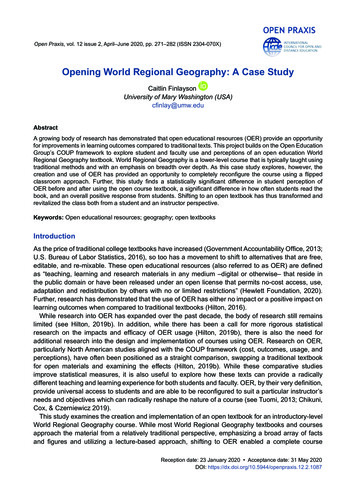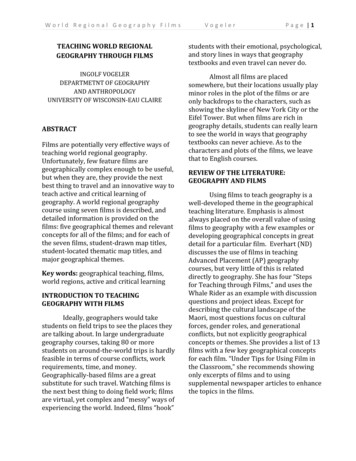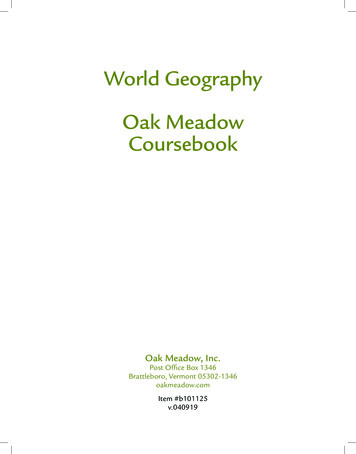
Transcription
World GeographyOak MeadowCoursebookOak Meadow, Inc.Post Office Box 1346Brattleboro, Vermont 05302-1346oakmeadow.comItem #b101125v.040919
Table of ContentsIntroduction to World Geography. ixCourse MaterialsHow the Course Is Set UpEvaluating Internet SourcesHow to Read Research MaterialsProject TipsSemester Reading ProjectReading Project Selections: NonfictionReading Project Selections: FictionKey 21st Century Skills and CompetenciesFor Students Enrolled in Oak Meadow SchoolUNIT I: Earth, Our Home PlanetLesson 1: Geography Skills. 3Tools and terms of geographyMap projectionsLesson 2: Human Geography.9Human-environment interactionCultural and spatial diffusionDifferentiating between fact and opinionLesson 3: Planet Earth. 15Natural forces that shape the EarthWater cycle and global water issuesLesson 4: Climate Patterns. 21Weather patternsGreenhouse effect and climate changeOak Meadowiii
ContentsWorld GeographyLesson 5: Interest-Led Learning. 25Self-designed projectUNIT II: North and Central AmericaLesson 6: Landforms of the United States and Canada. 35Geographic landforms and featuresLesson 7: Human Geography of the United States andCanada. 41Demographics and cultural influencesLesson 8: Natural Features of Mexico, Central America, andthe Caribbean Islands. 47Desert, rainforest, and marine ecosystemsLesson 9/10: Research Project: Mexico, Central America,and the Caribbean Islands. 51Student-designed research projectUnit III: South AmericaLesson 11: Physical Geography of South America. 57Climate zonesRainforest biodiversity and environmental concernsLesson 12: Cultural Geography of South America. 61Rural and urban population densityDeveloping just lawsLesson 13: Interest-Led Learning. 65Self-designed projectUnit IV: EuropeLesson 14: Geographical Regions of Europe. 75Geographic featuresNatural resourcesivOak Meadow
World GeographyContentsLesson 15: European Demographics and Government. 79Population patternsGeographic features related to historyLesson 16: European Cultures and Lifestyles. 85International cooperationEconomic changesEthnic diversity and conflictsLesson 17/18: Semester Project and Lab. 89Self-designed studyLearning reflectionLab activityUNIT V: Russia and Central AsiaLesson 19: Natural Features of Russia and Central Asia. 107Climate zonesCapitalizing on natural resourcesLesson 20: Human Geography of Russiaand Central Asia. 113Soviet Union and post-Soviet Russia and Central AsiaCensorshipLesson 21: Interest-Led Learning. 119Self-designed projectUNIT VI: AsiaLesson 22: Geography and Cultures of East Asia. 129Diet and geographyLarge-scale changes to the environmentLesson 23: Geography and Cultures of South Asia. 135Data interpretationBias in news articlesOak Meadowv
ContentsWorld GeographyLesson 24: Geography and Cultures of Southeast Asia. 141Volcanos and tsunamisRainforest managementLesson 25: Geography and Cultures of Southwest Asia(Middle East). 147Peak oilWater crisisLesson 26/27: Research Project: Asia. 153Student-designed research projectUNIT VII: AfricaLesson 28: Landforms and Features of the AfricanContinent. 159Wildlife unique to AfricaDesertificationLesson 29: Cultural Geography of Northern Africa. 163Water managementPreserving cultural sitesLesson 30: Cultural Geography South of the Sahara. 167Agriculture and hungerGame preservesLesson 31: Interest-Led Learning. 173Self-designed projectUNIT VIII: Australia, Oceania, and AntarcticaLesson 32: Physical and Cultural Geography of Australia.183Great Barrier ReefWater system managementLesson 33: Physical and Cultural Geography of Oceania.187Types of islandsEl Niño-Southern OscillationviOak Meadow
World GeographyContentsLesson 34: Geography of Antarctica. 193Antarctic TreatyIce shelvesLesson 35/36: Semester Project and Lab. 197Self-designed studyLearning reflectionLab activityAppendix. 215Elements of Good WritingVaried SentencesStrong ParagraphsThe Writing ProcessPrewriting ExercisesFive-Paragraph EssayComparative EssayMultimedia PresentationsWriting a Research PaperCiting Your SourceSpecial Considerations for Citing ImagesPlagiarismOak Meadowvii
Introductionto World GeographyGeography is not just about learning the names of cities, rivers, and mountain ranges. The studyof geography involves understanding the natural forces that shape our planet and the interactionsbetween people and their environment. It’s about how human activity can modify the surfaceof the Earth itself and inform the region’s culture and inhabitants over time. This course is alsoabout acquiring information from disparate sources, like maps, statistics, news reports, andliterary accounts, and integrating it into a comprehensive understanding. The projects and assignments in this course will exercise your imagination, creativity, analytical mind, and critical faculties.Overall Course Objectives: Understand and use terminology of physical and human geography. Exhibit different types of writing for different purposes. Locate and evaluate sources for relevance and reliability. Interpret data presented in different forms. Compile data and display it in a variety of graphic forms. Become familiar with current issues related to different geographical regions. Initiate and engage in interest-led learning projects.This course gives you many opportunities to explore areas of interest through self-designedprojects. As you learn about the topics in each lesson, follow ideas and events that spark yourcuriosity, and take the time to find out more. The best way to get the most out of this course is tomake it personally meaningful—as an independent learner, you have the freedom and flexibility todo that!Note about Work LoadPlease note that there are a wide variety of assignments included in this course to give youmany options for engaging with the material. Students are not expected to complete everysingle assignment. You can ask your supervising teacher or parent for help determining whichOak Meadowix
Introduction to World GeographyWorld Geographyassignments to focus on each week, based on your interests, strengths, and areas needingdevelopment. You might also prefer to complete some of the written assignments orally with yourteacher or parent. Keep an eye on the work load as you progress through the course, and makeadjustments so that you have time for meaningful learning experiences rather than rushing totry to get everything done. If you are enrolled in Oak Meadow School, please consult with yourteacher when making adjustments to the work load.Course MaterialsThis coursebook contains all the instructions and assignments for the full-year course. Thiscourse is designed to be textbook-independent. This means that the course is driven byquestions and inquiry that challenge you to become a researcher and a critical thinker. You canuse ANY textbook (one or more) or other research materials to learn about the lesson topics.Throughout the course, you are encouraged to use a wide variety of sources such as nonfictionbooks, websites, films, textbooks, journals, novels, artwork, news archives, etc. You are welcometo purchase a textbook to use as your primary reading material, or use any combination ofmaterials, but there isn’t one specific textbook attached to this course. In fact, you shouldconsider augmenting any textbook you use with additional print and online resources to helpmake your understanding of geography more complex and vital.In each lesson, you’ll find a range of topics to research. You aren’t expected to gain acomprehensive body of knowledge on each topic—save that for the topics you are excited about.For most topics, you will read just enough to get a general idea of it. Interspersed with thecontent-rich lessons that have a lot of research and reading, you’ll find lessons that give you theopportunity to process what you have been learning through creating projects of your own design.The goal of these lessons is to reflect on what you have learned, and to spend time on a project ofpersonal relevance to you. The choice is totally up to you, but you’ll get more out of this courseif you try your hand at a variety of types of projects (research projects, essays, creative projects,experiments, etc.) and dive into topics with which you are not yet familiar.This course makes good use of technology and the vast resources found online (see EvaluatingInternet Sources below). If you don’t have internet service at home, you are encouraged to dothe online activities at your local library. If you are unable to use the internet, please talk to yourteacher about alternative assignments. Of course, you’ll also find valuable resources in print atyour local library and librarians often have a wealth of knowledge to share.How the Course Is Set UpIn this course, there are 36 lessons divided equally into two semesters. Each lesson beginswith a short introduction which often includes background information as well as ideas foryou to ponder and discuss with your parents and friends. By discussing issues, expressing yourxOak Meadow
World GeographyIntroduction to World Geographyopinion, and listening to the opinions of others, you will come to a clearer and more in-depthunderstanding of the topics in each lesson.Lessons are divided into sections to guide your studies and enhance your understanding of thematerial. An Assignment Checklist is found at the beginning of each lesson so you can see at a glancewhat you’ll be doing, and check off assignments as you complete each one. Assignments arefully explained in the lesson. Lesson Objectives outline the main goals of the lesson and give you an idea of what to expect. Comprehension and Critical Thinking Questions are designed to help you solidify key concepts and knowledge, think deeply about the material, and apply your knowledge and yourreasoning skills. Mapping the World is a year-long project in which you will be drawing a world map, addingnew sections as you learn about each region. Semester Reading Project reminders are included periodically to help you make steady progress on reading and analyzing one book per semester (see below for details and bookselections). Central Questions prompt you to think about the deeper connections, issues, and concepts.Take your time pondering the central questions before responding to them. Discussing thesequestions with others will help clarify your own ideas and opinions. Activities provide a wide range of ideas for exploring the topics you are studying. All activitiesare optional and you are encouraged to do any that interest you. For Enrolled Students sections at the end of most lessons provides reminders and information for students who are enrolled in Oak Meadow School and submitting work to their OakMeadow teacher.Reading sections outline the topics you will research and study using a variety of sources;consider the list of reading topics to be a starting point for your learning.The appendix contains important material that you will be expected to read and incorporate intoyour work throughout the year. Take some time to familiarize yourself with the resources in theappendix. You will find information about writing techniques and composition formats, how toavoid accidental plagiarism, and details on citing sources and images.It is assumed that you will be working with an adult who assesses and supports your learningwhether you are enrolled in Oak Meadow or are using this course independently. This teacher—who may be a parent, tutor, or Oak Meadow teacher—is the one to whom you should turn if youhave questions about your assignments or how to get the most out of this course.Oak Meadowxi
Introduction to World GeographyWorld GeographyIf you are an enrolled student in Oak Meadow’s distance learning program, be sure to look closelyat the Google course doc your Oak Meadow teacher sends to you as your teacher may havemodified your course and your lesson requirements.Evaluating Internet SourcesYou’ll have plenty of opportunities to do online research, and you are encouraged to find videos,images, and articles about any of the topics you find interesting. The best way to learn is to followyour interests in any given subject. BE AWARE, however, that many online resources have nobasis in fact and even commonly used resources like Wikipedia are full of errors and half-truths.When doing research online, be sure to examine who is writing what you are reading. Considertheir intent and inherent bias. Materials produced by colleges and universities and written by wellknown scholars are your best bet for finding meaningful, relevant information to help you withyour course.When you do online research, avoid drawing conclusions before you’ve checked the informationfor reliability. Often, you can tell when a website contains bias or is opinion-based. Some siteslook very convincing, but contain information that is not supported by scientific evidence orexperimentation. When you are uncertain of a source’s reliability, consider the following criteriabefore you decide to use the information in your research: The authors make their case based on adequate evidence.The authors interpret the data cautiously.The authors acknowledge and deal with opposing views or arguments.The authors give a list of current sources that support their claims.Some characteristics of unreliable websites require practice to identify. One trick is to look atthe sources that are linked in the article you want to verify. These links can give you some ideaof reliability. If your source is linked to a number of questionable sites, it’s probably not a goodsource. Characteristics of unreliable websites: xiiThe authors make extraordinary claims with little supporting evidence.The authors relate evidence based on personal experience instead of referring to controlledstudies.The author appeals to emotion rather than logic.The authors misrepresent or ignore opposing views.The arguments are biased to support a political or economic agenda.The site is linked to sites that support a particular political or economic agenda.Oak Meadow
World GeographyIntroduction to World GeographyYou will find a resource page for this course on the Oak Meadow website (www.oakmeadow.com/curriculum-links/). This page will include a variety of online sources that you might finduseful in this course. These links are meant to help you in your research, not take the place of it—consider them a starting point.How to Read Research MaterialsIt can be challenging to absorb research materials, particularly if they are written for adultsinstead of teens. Here are some tips: Pay attention to the key concepts, section headings, and main ideas in any article or text youare reading. It is helpful to look over the entire piece to get an idea of what it covers beforeyou begin reading it.The most important words to focus on are the ones you don’t understand. Take the time tolook up words you don’t know so you can comprehend what you are reading.Pay special attention to the images! This cannot be emphasized enough. The diagrams, maps,charts, and illustrations are sometimes easier to understand than the text. They often provideinformation in a way that your brain can make sense of more readily and will help you betterunderstand what is written.Learn how to take good notes. Find a method of note-taking that works for you, and use it tokeep track of key ideas while you read.Use your notes! Taking notes is helpful for storing information in your long-term memory, andreferring to them when completing your assignments helps jog your memory, letting you makemore meaningful connections between topics.Project TipsThroughout this course, you will have the opportunity to develop many projects of your owndesign, based on your interests and questions that are important to you. Here are some tips thatwill help you with designing and creating meaningful projects. Choose a topic that engages your curiosity. Choose a topic that you want to know moreabout, or consider tackling a topic or question that puzzles you. If you’re having troublefinding a topic, talk to your teacher. Start early! Starting early also gives you time to revise your design as you learn more, changethe focus, and prepare a presentation that means something to you. Set small goals for yourself within the project. For example, if you have one week in which todo a project, you may want to assign yourself daily goals. Small goals are easier to accomplishthan one big project, and will help you track your progress.Oak Meadowxiii
Introduction to World GeographyWorld Geography Don’t believe everything you read, hear, or watch. Question the reliability of all of yoursources, especially the news media outlets. Government agencies, professional associations,museums, or known scientific journals are generally reliable sources. It is important to confirminformation by using a variety of sources. Keep track of your notes. Writing notes in your own words helps you retain information moreeasily. It is important to know which source your information comes from. Include citationinformation with your notes so you can go back to confirm data or gather more informationas necessary.Keep in mind that your project will be shared with others. Give some thought to the final form itwill take, and try out different forms with each project. The goal is to convey your information ormessage in a way that others will understand or benefit from. Be clear about what informationis factual and what is your opinion. Show how the evidence you gathered supports yourconclusions. If you are using graphs or tables, make sure they are easy to read. When relevant,give details about how and where you got your information. Even if you are presenting yourfindings in a creative manner, you should be able to explain the facts behind your work.Semester Reading ProjectIn addition to your assignments and projects in each lesson, you will read one additional bookeach semester. A list of book choices appears below. If you would like to read another relevantbook not listed, discuss it with your teacher.As you’re reading your chosen book throughout the semester, use your critical and analyticalfaculties to assess the book, and your responses to it. Pay attention to passages in the book thatintrigue you, frustrate you, or remind you of related subjects you may want to investigate morethoroughly. Jot down notes as you read—these will help you when you write your final project foreach book (see lesson 2 for more details). You have the entire semester to read your book.Work on your ability to synthesize the information you are reading, compare or combine it withinformation in other books, and to express the book’s ideas in your own words with clarity andpurpose. Novels, for example, though fictional, often contain valuable insights about life duringa particular time period or in a particular place. Geography has connections to a wide rangeof other subjects, including science, history, and the arts, and learning about any of these canilluminate your understanding of geography.xivOak Meadow
World GeographyIntroduction to World GeographyReading Project Selections: NonfictionAn Inconvenient Truth: The Crisis of Global Warming by Al GoreClimate change, global warming, and our own responsibility in responding to it are broughtinto focus with vivid images and graphics. This book is a clarion call to action.The Coming Plague: Newly Emerging Diseases in a World Out of Balance by Laurie GarrettAs humanity expands and moves into new areas of the globe, technologies that enableour way of life also provide opportunities for diseases to flourish. This book examines theintersection between globalization, ecology, and disease.How to Lie with Maps by Mark MonmonierThis clever and revealing book shows how people manipulate maps to sell their version of thetruth, and gives readers the tools to evaluate maps with a healthy skepticism.Krakatoa: The Day the World Exploded: August 27, 1883 by Simon WinchesterConnecting history and geology, this book describes the devastating volcanic eruption thatclaimed nearly 40,000 lives. Eyewitness accounts give a picture of humanity’s exceptionalability to recover from disasters and rebuild.A Crack in the Edge of the World: America and the Great California Earthquake of 1906 by SimonWinchesterPlate tectonics were responsible for the disaster in San Francisco, but the fire that was ignitedby the earthquake raged for three days and burned much of the great city to the ground. Thisbook explores how profoundly geological phenomena can affect human culture.Before the Dawn: Recovering the Lost History of Our Ancestors by Nicholas WadeUsing DNA analysis, geneticists can trace the movements of a small band of human ancestorsfrom east Africa about 50,000 years ago. This book explores genetic evidence regarding theorigins of humanity, race, language, social behaviors, and cultural practices, and looks athow an evolutionary event is recorded in DNA.Guns, Germs, and Steel: The Fates of Human Societies by Jared DiamondA comprehensive look at how geography and environmental influences shape human society,this book, which won the Pulitzer Prize, traces a clear path of human development in eachregion of the world.The World Until Yesterday: What Can We Learn from Traditional Societies? by Jared DiamondBased on the author’s experiences over 50 years in New Guinea and neighboring islands,this book details the traditional culture which, until recently, had little or no influence fromindustrial Western societies.Oak Meadowxv
Introduction to World GeographyWorld GeographyCollapse: How Societies Choose to Fail or Succeed by Jared DiamondWhy have so many ancient empires collapsed, leaving only elaborate and mysterious ruins?This book uses recent archaeological and paleoclimatic studies to explore the role ofenvironmental factors in societal collapses.Mountains Beyond Mountains: The Quest of Dr. Paul Farmer, a Man Who Could Cure the World byTracy KidderThis biographical book details the life of Dr. Farmer as he works to cure infectious diseasesand improve the health and lives of people in Haiti, Peru, Cuba, and Russia.Child of the Dark: The Diary of Carolina Maria de Jesus by Carolina Maria de JesusThe journal chronicles life for the poor in Brazil’s favelas (slums). A hard look at what the poorhave to do to survive, this true account drew attention to social problems for the poor aroundthe world.Goodbye to a River: A Narrative by John GravesBefore a series of dams along the Brazos River in Texas are built, the author undertakes afinal canoe journey to experience the natural beauty before it is forever changed.Cadillac Desert: The American West and Its Disappearing Water by Marc ReisnerWater has defined the American West, from its earliest inhabitants to modern day politicsand business. This hard-hitting book exposes widespread corruption and ecological damagein the never-ending battle for water rights.Diamond: A Journey to the Heart of an Obsession by Matthew HartDiamonds have captivated the passion and imagination since they were first discovered. Thisbook explores how this gem has wielded its influence on environmental, social, political, andeconomic levels.An American Plague: The True and Terrifying Story of the Yellow Fever Epidemic of 1793 by JimMurphyWith a powerful narrative, the author traces the disease and its aftermath in Philadelphia,which was, at that time, the capital of the new nation.The Endless Steppe: Growing Up in Siberia by Esther HautzigA true-life account of a family exiled to Siberia and learning how to eke a living out of theharsh land of the Siberian steppe.Stuffed and Starved: The Hidden Battle for the World Food System by Raj PatelA complex investigation of global food systems and why people are starving in somecountries while other countries have such an abundance of food that it is wasted by the tonxviOak Meadow
World GeographyIntroduction to World Geographyand elsewhere farmers are paid not to produce food. This book offers a glimpse at how tocreate a balanced, sustainable food system.The Log from the Sea of Cortez by John SteinbeckThis book recounts the experiences of Steinbeck and a biologist friend as they explore theGulf of California. A lively blend of science, philosophy, and adventure.The Horse, the Wheel, and Language: How Bronze-Age Riders from the Eurasian Steppes Shaped theModern World by David W. AnthonyHow did so many modern languages spring from the same source? Combining archaeology,history, cultural migrations, and technological innovations, the author traces the spread ofIndo-European languages from ancient history to today.Banana: The Fate of the Fruit That Changed the World by Dan KoeppelFrom jungle to high-tech labs, this entertaining and surprisingly revealing examination of acommon fruit shows how human and physical geography interact and influence one another.The Boy Who Harnessed the Wind by William Kamkwamba and Bryan MealerA true story of what happened when the author’s small village in Malawi lost their crops to asevere drought. Kamkwamba’s account of how he built a wind generator from scrap metal isan inspiring memoir.The Snow Leopard by Peter MatthiessenThe moving account of a physical and spiritual journey into the remote mountains of Nepal,the author and a field biologist seek the rare snow leopard.Desert Solitaire by Edward AbbeyAs a park ranger and conservationist, the author offers a unique collection of poeticaccounts of life in the desert.Reading Project Selections: FictionCry, the Beloved Country by Alan PatonThis dramatic, moving novel tells the story of a Zulu pastor in South Africa and his son, livingthrough the social injustices of apartheid. Considered a classic work showing how courageand dignity shine through during humanity’s most challenging times.The Years of Rice and Salt by Kim Stanley RobinsonThe Black Death killed 30% of the population of Europe during the 14th century. In thisscience fiction epic, the author asks: What if it had killed 99% instead? This story presentsa 700-year “alternate history” of what the world might have looked like without Europeancolonization.Oak Meadowxvii
Introduction to World GeographyWorld GeographyThe Poisonwood Bible by Barbara KingsolverThe setting of the Belgian Congo provides a rich backdrop for this novel about a family whomoves from the U.S. to Africa to work as missionaries in a place where the natural worldstrongly influences the lives of the native people and the newcomers alike.Things Fall Apart by Chinua AchebeThis illuminating tale from African author Achebe portrays life in Nigeria before and aftercolonial rule. Complex characters and cultural conflict create an authentic story with greatdepth and relevance.A Thousand Splendid Suns by Khaled HosseiniAfghan-born Hosseini tells the story of two women living in Afghanistan under the Talibanrule. Mirroring the harsh realities of the country, their brutal lives draw them together inunexpected friendship and love.The Alchemist by Paulo CoelhoWhen a young shepherd goes on a quest in search of hidden treasure, his travels take himfrom Spain to Egypt, gathering along the way inner knowledge more valuable than the richeshe seeks.Treasure Island by Robert Louis StevensonA classic novel that combines geography and a detailed sense of place with an exciting searchfor pirate treasure. Memorable characters and lively action create a story for the ages.The Winter King by Bernard CornwellA King Arthur tale that takes the reader from Wales to Scotland to Britain. Geography andhistory are woven together as the landscape shapes the characters and their actions.The Call of the Wild by Jack LondonBased on the author’s experiences and fascination with the Klondike, this classic adventurestory follows a dog who is pushed into the harsh environment and brutal greed of theKlondike Gold Rush.Key 21st Century Skills and CompetenciesAs culture and technology have modernized and globalized, key essential skills have emerged.Rather than the emphasis on memorization and single-view answers, citizens today areencouraged to think broadly and flexibly. This applies to educational, political, and social realms.In this course, you will be engaging skills such as the following: xviiiIdentify main ideas and supporting details.Use contextual clues to make inferences.Oak Meadow
World Geography Introduction to World GeographyAnalyze cause and effect.Compare and contrast to identify similarities and differences.Summarize data.Draw conclusions.Make predictions.Analyze media content (images, political cartoons, ads, etc.).Analyze primary and secondary sources.Consider divergent viewpoints.Identify bias and differentiate between fact and opinion.Organize data in a variety of ways.Read maps, charts, graphs, and tables.Pose informed questions.Avoid plagiarism.Evaluate the validity of a source.Identify patterns and trends.Synthesize information from a var
World Geography Introduction to World Geography Oak Meadow xi opinion, and listening to the opinions of others, you will come to a clearer and more in-depth understanding of the topics in each lesson. Lessons are divided into sections to guide your
